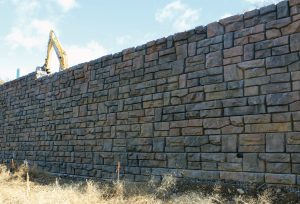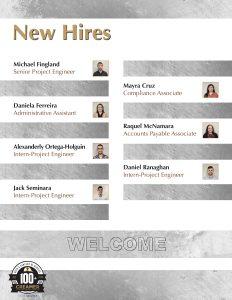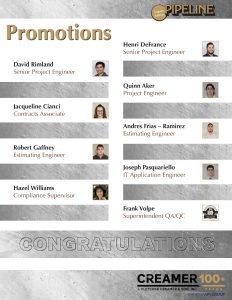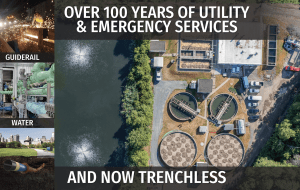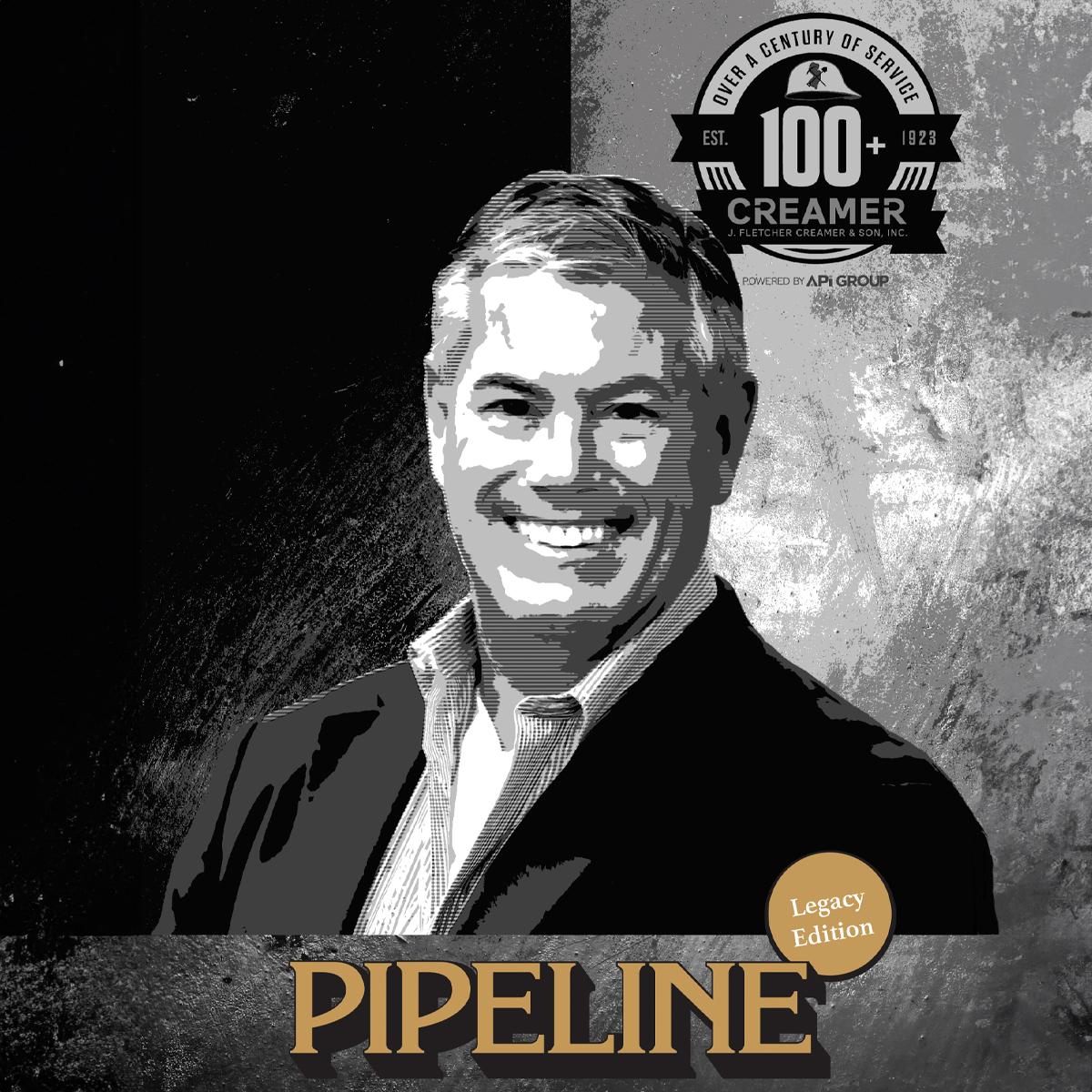
As J. Fletcher Creamer & Son moves into its 101st year in business, we are poised to continue to grow our relationships with our clients and to introduce new technologies that will further improve the quality of life in the communities in which we work.
From the original vision the Creamer family had for the company, to the expansion into Fiber Optics and the creation of our Training Center under the guidance of the late Joe Walsh, and now a focus on client service and innovation under the leadership of Martin Downs, Creamer is constantly evolving to ensure that we are an industry leader. However, there is one core value that is our company’s foundation, that gives us that ability to confidently augment our core services; that foundation is safety.
The safety of our employees, our clients and the public has always been our number one core value. And, while it has always been viewed as a solid foundation to build upon, that does not mean that safety hasn’t been evolving along with the rest of the company. I would like to take the opportunity in this Executive Message to highlight some of those changes and share the concepts that Creamer is currently executing that we believe have helped our team members, clients and the general public. I encourage the readers of this article to engage with our teams when you see them and ask questions about these ideas.
Safety professionals in the past were viewed by the field as the “safety police”. You’ve undoubtedly heard countless stories about the struggle between safety and field throughout the industry. One of the widespread classic stories is about safety inspectors that would hide in their cars or behind objects on the site to “catch” one of their co-workers doing something unsafe and then punish them. At Creamer, we have successfully moved far away from those types of interactions. Our Safety Superintendents actively engage with project teams at each and every stage of the process – starting at the estimating table and continuing throughout the duration of each project. Sometimes, our Safety Supers will lead our morning Job Hazard Analysis (JHA) and other times they will act as a participant while one of our Foremen or Journeyman leads the discussion. In other words, they are a crucial part of every Creamer project team.
In the “old days” the responsibility for safety used to lie with the Safety Professional; this reinforced the concept of the “safety police” that used to exist. In making our safety professionals part of the team, we also have made sure to reinforce the fact that the responsibility for safety lies with every person on-site – everyone can “stop the job”. Creamer created our “Safety Commitment” that we share at each of our company-wide meetings and discuss in our field meetings:

Shifting the mindset from one focused on production where safety was an inconvenience to one in which everyone believes the most important thing in their day is their responsibility to ensure the safety of themselves and those around them has not been an easy task. This is something that we must
reinforce continually as new team members join our company. However, being able to work alongside clients who share Creamer’s commitment to safety has been a big help.
Creamer believes that building trust and ensuring good communication is key to every aspect of our business. This has been the cornerstone of the company since the Creamer family founded the business over one hundred years ago. That same commitment to communication has been integrated into our safety efforts. We feel it is important to share both the good and the bad examples of jobsite safety with the entire company. We share good catches, recognize exemplary performance, as well as notify our team members when a safety incident has occurred. There are lessons to be learned in everything we do; we do not let those lessons go unlearned and kept with only a few individuals. We have a lot of smart people with lots to contribute on our teams, it would be a shame to let that resource be untapped. These communications allow our whole company to participate in suggesting improvements to our safety program.
In the same vein, we have recently made another change in our approach to how we start every day. Our JHAs have been modified to include a brainstorming section at the top of each report. This is in addition to our interactive electronic form where the JHA leader is discussing the safety topics relevant to the tasks they are about to perform. The focus of the brainstorming section is for our teams to name the most dangerous things that they will encounter during each day. This purposeful focus on those top risks helps our teams remember that despite being experts at their craft, where the ability to perform at a high level comes naturally to them, that some of the work they perform also comes along with steep consequences if not executed safely.
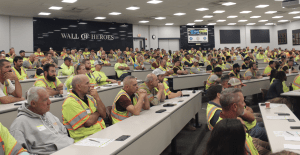
At a very high level, this is where we are today. There are too many actions, programs and initiatives that build these overarching themes and make up Creamer’s safety culture to name, but if you have a chance to speak with any of our Safety Superintendents, I’m sure they would be happy to talk about it and take suggestions on best practices that other organizations are following. I cannot thank our crews and various team members throughout the Creamer family enough. Their contributions to solidify our foundation of safety are unending. I am amazed at what this company has been able to accomplish over its 100+ year history and look forward to the next century with great pride and excitement.
– Daniel Fowler
Vice President
Corporate Services & Special Projects

As the sun sets on Dale Creamer’s illustrious four-decade career at J. Fletcher Creamer and Son, Inc., the company pauses to reflect on the journey of a man who epitomizes the Creamer’s ethos – dedication, hard work, camaraderie, and family values. From his early days as a laborer to his tenure as Vice President of Operations and later Executive Vice President, Dale’s journey is not just one of professional achievement but also a testament to the values instilled by generations before him.
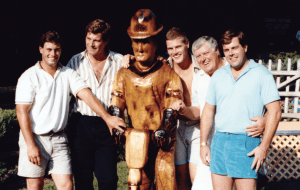
Dale’s path into the family business was inevitable. His grandfather, J. Fletcher Creamer II, laid the foundation, and his father, Fletch Sr., continued the legacy, eventually passing the torch to his sons, Fletch Jr., Glenn, and Dale. “It was a way of life for all of us in the Creamer family,” Dale reflects, reminiscing about summers spent working at the company since the age of 12. “Our father was adamant about working with the crews. It was important to him, and us, that we all knew the issues crews faced in the field on a daily basis” remembered Dale’s brother Glenn.
Upon graduating from Fairleigh Dickinson University in 1985, taking night classes his senior year so he could work during the day, Dale officially started his career at Creamer. Over the years, he wore many hats and was always willing to take on the challenging jobs, whether plowing snow at the Meadowlands for the Superbowl or starting a new, cutting edge, line of business for the firm. Dale’s tenure was marked by a commitment to excellence and a knack for tackling challenges head-on.
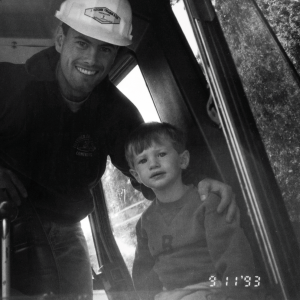
One of the hallmarks of Dale’s career was his instrumental role in spearheading the company’s foray into pipe rehabilitation. Reflecting on this pivotal moment, Dale shares, “It was nice to grow it from cradle to adulthood, and getting a new line of business started is something I’ll always be proud of.” The work in pipe lining took Dale from New Jersey to California – where he helped open a Creamer office and formed crews that would go on to line hundreds of miles of pipe for the Los Angeles Department of Water and Power. His dedication and vision laid the foundation for what would become a cornerstone of Creamer’s operations.
“Dale always embodied the spirit of Creamer,” reflects Marty Downs, President of J Fletcher Creamer and Son, Inc. “His selfless commitment to the company and its success is a testament to his character and dedication.”
Yet, Dale’s legacy transcends mere professional achievements. At the heart of his tenure lies a deep-seated commitment to the people who make Creamer what it is – a family. “Creamer is all about its people,” Dale emphasizes. “Making team members happy has a trickle-down effect to everything we do.” Longtime co-worker and Creamer’s Director of Construction Services, Frank Pietropaolo, who lovingly refers to Dale as “the Pitbull” always knew his door was open and he could count on not only professional, but personal advice from his friend. This sentiment was echoed by Rick DeNicola, Creamer’s Vice President of Operations. “Working for Dale was always a pleasure. I learned a lot from him, especially at the countless emergency projects he volunteered me for over the years,” DeNicola jokes. “But seriously,” he continued, “without Dale’s guidance and the opportunities he gave me, I would not be where I am today. I will always cherish our close working relationship as well as his friendship outside of work.”
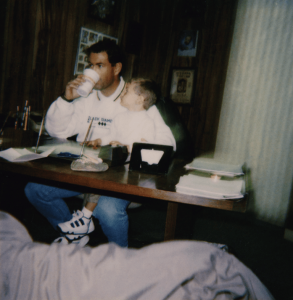
His leadership style earned him the respect and admiration of colleagues. “Dale reminded me of his father the most in many ways, including his fearlessness and entrepreneurial spirit,” remarks Andy Wood, Chief Financial Officer at J Fletcher Creamer and Son, Inc.
As Dale bids farewell to the company, he has called home for over four decades, his departure leaves an indelible void. “Dale had a work ethic that was ingrained in us by our mom and dad,” reflects his brother, Fletch Jr. “Being able to watch him grow over the years as a person, father, and business owner, was tremendous.”
But as one chapter closes, another begins. For Dale, retirement beckons with promises of leisure, family time, lots of fishing and new adventures. In celebrating Dale Creamer’s remarkable career, J. Fletcher Creamer and Son, Inc., pays homage to a man whose legacy will endure as a beacon of inspiration for generations to come. As the company marches forward, guided by the principles of integrity, excellence, and kinship, Dale’s spirit will continue to illuminate the path ahead.


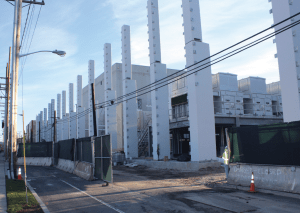
J. Fletcher Creamer & Son, Inc. is proud to highlight the technical feats achieved at the soon to be completed Orange Heights Switching Station (the “Project”). This endeavor marks a significant milestone in the upgrading of electrical infrastructure in an area of the state that is experiencing rapid development and population growth.
The Project involved the deployment of three distinct voltage levels – 230kV, 69kV, and 4kV – in order to cater to diverse energy requirements with precision. Creamer’s work on the Project extended from below-grade work encompassing underground duct banks to above-grade civil infrastructure, coming together to form a seamless integration of electrical and structural elements.
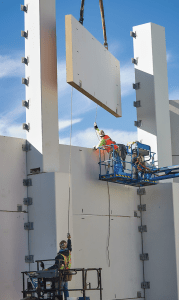
Situated in a flood zone, the Project necessitated meticulous planning by Project Engineer Mobin Malik to safeguard against potential inundation. The strategic elevation of the Orange Heights Switching Station, coupled with comprehensive drainage systems featuring bioretention stations, underscores a proactive approach towards resilience in the face of natural challenges.
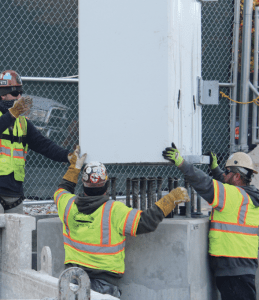
At the core of the Project lies the construction of a Gas Insulated Substation (“GIS”). This structure allows for the containment of high voltages within a compact footprint, optimizing spatial efficiency while ensuring robust weather protection. GIS provides greater reliability to system users by utilizing inert gas sulfur hexafluoride (“SF6”) for insulation and quenching of electric arcs, as opposed to the traditional air-insulated technology. Without the GIS building, the requisite footprint would have expanded exponentially, which was not an option at the Orange Heights Switching Station site.
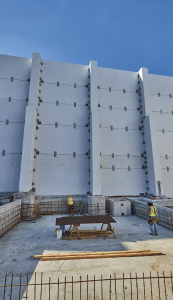
“Working to keep our client’s tight schedule was the largest challenge on this job”, said Doug Trosky, the Project Superintendent for Creamer. Equipment for the Project was sourced from all over the globe, and missing a deadline could have led to a domino effect that extended the project completion date by years. Thankfully, Creamer’s Project Manager, Alex Terenik, was in constant communication with our partners and their suppliers. This combined with upwards of six Creamer crews working 6-7 days a week, Terenik, Trosky, and their team met all project milestones with no major delays.
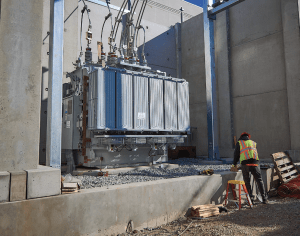
The success of the Orange Heights Switching Station not only bolsters the region’s electrical resilience but also serves as a testament to Creamer’s exemplary performance. Don Smart was the Estimator on this project and Chris Mabie was the General Superintendent.
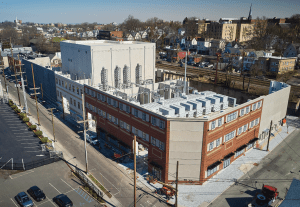
As the Project nears its completion in June 2024, it leaves a lasting legacy of technological innovation and collaborative excellence. With the prospect of further expansions on the horizon, Creamer stands poised to continue its legacy of excellence in shaping the future of electrical infrastructure.
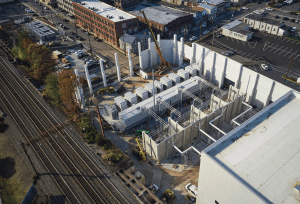

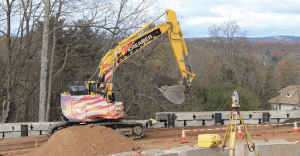
Facilities and equipment management is a constant struggle for companies large and small. J. Fletcher Creamer & Son, Inc. knows this firsthand and works to help clients meet their operational needs. This is evident in their Phase 1 work at Veolia Water New York Inc.’s (“Veolia”) headquarters in West Nyack. The project team performed a range of services in the Creamer catalog to streamline operations and enhance efficiency for Veolia. Central to this endeavor was the expansion and enhancement of the existing property to accommodate the consolidated operations seamlessly.

One of the main tasks of the project was constructing new drainage and stormwater runoff systems for the site. Under the supervision of General Superintendent Paul Corvino, Superintendent Colin Cavanagh and Project Foremen Chris Ferise and Joe Costeira performed the excavation and construction of two new detention basins with water quality units for stormwater runoff. Creamer also installed 1,500 linear feet of High-Density Polyethylene (“HDPE”) drainage piping with associated precast catch basins and manholes. The need for this new drainage became all too clear to the team in Fall of 2023 as the site experienced frequent & heavy rains which negatively impacted site conditions. The perseverance of Creamer’s field leadership and constant collaboration with the client’s project management team rendered these constraints seemingly futile.
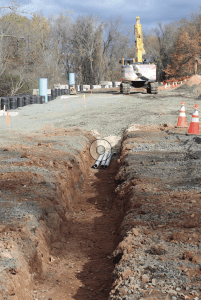
Additional site work included the construction of a 600 linear foot retaining wall that reached heights of 10’-15’ from pre-existing grade and significant electrical upgrades. Crews laid new conduit to accommodate future Electric Vehicle Charging Stations and improved site lighting coupled with the installation of a plethora of new light poles. The installation of timber guide rail, concrete curbing, sidewalk, and new fencing rounded out the Phase 1 work. The range of techniques and processes featured on this project required an astute attention to detail from inception to completion. Chief Estimator, Dominick Genario and Project Engineers, Anthony Iarussi and Maciej Dlugosz made this seem effortless.
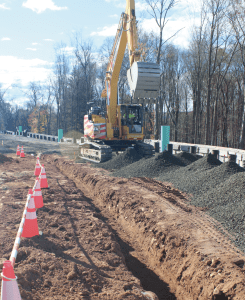
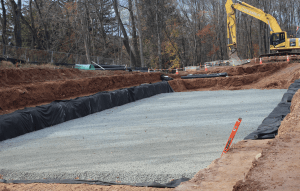
As the Veolia Water New York Inc. Operations Consolidation Phase I Project nears its completion, it leaves behind a legacy of collaboration, innovation, and achievement. Through detailed coordination and unwavering dedication, Creamer and Veolia have demonstrated their ability to surmount challenges and deliver excellence in construction.
